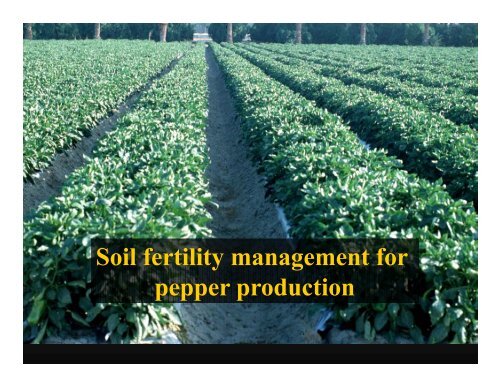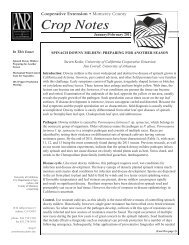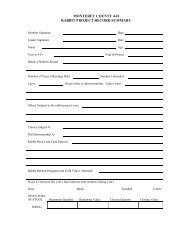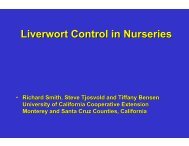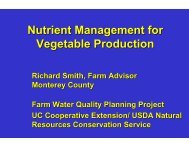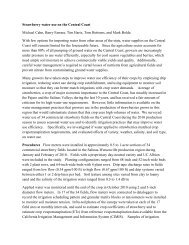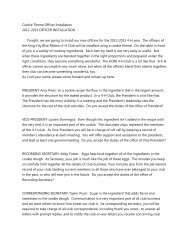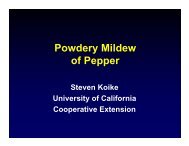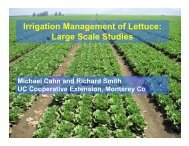Soil fertility management for y g pepper production
Soil fertility management for y g pepper production
Soil fertility management for y g pepper production
Create successful ePaper yourself
Turn your PDF publications into a flip-book with our unique Google optimized e-Paper software.
<strong>Soil</strong> <strong>fertility</strong> <strong>management</strong> <strong>for</strong><strong>pepper</strong> <strong>production</strong>
Typical nutrient uptake by a bell <strong>pepper</strong> cropproducing 50,000 lb of fruit/acre :lbs per acreN P 2 O 5 K 2 Ottl total plant content t 200 - 260 40 - 60 240 - 320fruit content 80 - 110 20 - 30 120 - 180additional fruit at ≈ 3 lb / ton
Phosphorus requirement <strong>for</strong> <strong>pepper</strong> :Common soil tests <strong>for</strong> P availability :Olsen (bicarbonate) test - extraction in sodium bicarbonate at pH 8.5best method if soil pH > 6.5Bray test - extraction in dilute aciduseful in acidic soil (pH < 6.5)Bray values higher than Olsen in most cases
Is P application always necessary ?What application rate is reasonable ?<strong>Soil</strong> P availability requirement :High LowLettucePepperTomato
Is P application always necessary ?What application rate is reasonable ?<strong>Soil</strong> P availability requirement :High LowLettucePepperTomato60 PPM 20 PPMAgronomic threshold(Olsen test)
Olsen P levelPepper response to applied P< 20 PPM positive response guaranteed20 - 40 PPM positive response possible, especiallyin cold soil> 40 PPM positive crop response unlikely
Olsen P levelPepper response to applied P< 20 PPM positive response guaranteed20 - 40 PPM positive response possible, especiallyin cold soil> 40 PPM positive crop response unlikelyApplication rate ?• limit application to crop removal rate in fields with high soil P• rates > 120-150 lb P 2O 5/acre questionable, regardless ofsoil test level
Nitrogen <strong>management</strong> :‣ Crop N uptake is predictable by growth stagelb N per acre per day:< 1 4 - 5 < 3
Nitrogen <strong>management</strong> :‣ Crop N uptake is predictable by growth stagelb N per acre per day:< 1 4 - 5 < 3‣ Not all N needs to come from fertilizer application:- residual soil NO 3 -N can be substantial- soil N mineralization can be up to 1 lb / acre / day
Excessive N application generally not an agronomic problem,but can be an environmental problem :‣ Environmental targets <strong>for</strong> N concentration in groundwater is10 PPM NO 3 -N; <strong>for</strong> surface water may be as low as 1 PPM‣ Any water that escapes a <strong>pepper</strong> field is likely to greatly exceedenvironmental targets
Irrigation i efficiency i and N <strong>management</strong> :‣ at common soil NO 3 -N levels during the season, one inch ofleaching may carry 20-30 lb NO 3-N/acre out of the root zone‣ that water may be 10 times the Federal drinking water standardof 10 PPM NO 3 -N 3
Potassium <strong>management</strong> :‣ Crop K uptake is predictable by growth stagelb N per acre per day:< 1 4 - 7 < 4
Potassium <strong>management</strong> :‣ Crop K uptake is predictable by growth stagelb N per acre per day:< 1 4 - 7 < 4‣ <strong>pepper</strong> has a moderately high K requirement (240 - 320 lb K 2 O/acre)‣ majority of K ends up in fruit‣leaf K declines to ‘feed’ the fruit; that’s why deficiency shows late
Evaluating soil K supply :‣ ‘exchangeable’ K, usually expressed as PPM‣ K as a % of base exchange[milliequivalent of K / (meq Ca + Mg + Na + K)] x 100
<strong>Soil</strong> test K interpretation :‣ fields > 200 PPM exchangeable K, and > 3% of base exchange,do not require K fertilization‣ soils < 150 PPM, or < 2% of base exchange, should be fertilized‣ K fertilization is most effective during fruit set andearly fruit development
Crop monitoring optionsIn-season soil nitrate testing : high root zone soil NO 3 -N concentration (> 20 PPM) indicatethat additional N application can be postponedp<strong>Soil</strong> nitrate testing most useful early in the season
Petiole testing as a <strong>management</strong> tool ?‣ high NO 3 -N or PO 4 -P concentration guarantees current sufficiency,but does not project far into the future
Petiole testing as a <strong>management</strong> tool ?‣ high NO 3 -N or PO 4 -P concentration guarantees current sufficiency,but does not project far into the future‣ lower NO 3 -N or PO 4 -P concentration does not prove deficiency
2004-05 survey of 75 coastal lettuce fields
at early heading stage :Leaf total N of the 20 highest yielding fields …% leaf N7.06.05.04.03.020 2.01.00.02 4 6 8 10 12 14 16 18 20CurrentsufficiencythresholdField
at early heading stage :Midrib NO 3 -N of the 20 highest yielding fields …15,000Mid drib NO3- -N(PPM)12,0009,0006,0003,000Currentsufficiencythreshold02 4 6 8 10 12 14 16 18 20Field
Tissue sampling in processing tomato : 4 high yield commercial fields UCD fertilizer trial
Tissue sampling in processing tomato : 4 high yield commercial fields UCD fertilizer trialLeaf N (gkg -1 )605040302010200 400 600 800 1000 1200Growing degree daysfield 1field 2field 3field 4UCD deficientUCD adequateUCD excessive
Tissue sampling in processing tomato : 4 high yield commercial fields UCD fertilizer trialLeaf N (gkg -1 )605040302010200 400 600 800 1000 1200Growing degree daysfield 1field 2field 3field 4UCD deficientUCD adequateUCD excessivePetiole NO3 3-N (PPM)15,00012,0009,0006,0003,0000200 400 600 800 1000 1200Growing degree daysfield 1field 2field 3field 4UCD deficientUCD adequateUCD excessive
Calcium disorders :‣ symptoms develop because insufficient i Ca is moved intoactively growing cells during fruit development
Calcium disorders :‣ symptoms develop because insufficient i Ca is moved intoactively growing cells during fruit development‣ origin of the problem is the inefficient way plants move Ca into fruit;soil Ca limitation i i seldom the primary problem
Calcium doesn’t move into fruit easily :Processing tomato fruit quality survey, 140 fields :FruitCa (%)0.400.300.200.100.000 2 4 6Leaf Ca (%)• Ca moves in transpirational flow in xylem, so leaf Ca is high• Ca does not move in phloem, so fruit Ca is low; surface waxon fruit makes foliar application questionable
What can be done to minimize i i calcium disorders d ? prevent water stress choose adapted varieties avoid high ammonium levels during early fruit development


